
Stanisław II August, known also by his regnal Latin name Stanislaus II Augustus, and as Stanisław August Poniatowski, was King of Poland and Grand Duke of Lithuania from 1764 to 1795, and the last monarch of the Polish–Lithuanian Commonwealth.
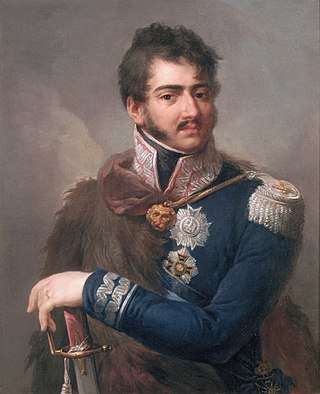
Prince Józef Antoni Poniatowski was a Polish general, minister of war and army chief, who became a Marshal of the French Empire during the Napoleonic Wars.
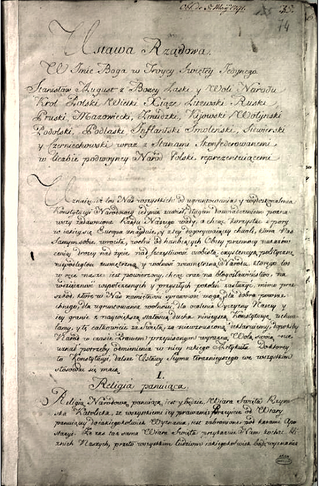
The Constitution of 3 May 1791, titled the Governance Act, was a constitution adopted by the Great Sejm for the Polish–Lithuanian Commonwealth, a dual monarchy comprising the Crown of the Kingdom of Poland and the Grand Duchy of Lithuania. The Constitution was designed to correct the Commonwealth's political flaws. It had been preceded by a period of agitation for—and gradual introduction of—reforms, beginning with the Convocation Sejm of 1764 and the ensuing election that year of Stanisław August Poniatowski, the Commonwealth's last king. It is the second constitution in history, after that of the United States.

The Royal Castle in Warsaw is a state museum and a national historical monument, which formerly served as the official royal residence of several Polish monarchs. The personal offices of the king and the administrative offices of the royal court were located in the Castle from the 16th century until the final partition of Poland in 1795. Situated in the Castle Square, at the entrance to the Old Town, the Royal Castle holds a significant collection of Polish and European art.

Stanisław Wawrzyniec Staszic was a leading figure in the Polish Enlightenment: a Catholic priest, philosopher, geologist, writer, poet, translator and statesman. A physiocrat, monist, pan-Slavist and laissez-fairist, he supported many reforms in Poland. He is particularly remembered for his political writings during the "Great (Four-Year) Sejm" (1788–92) and for his large support towards the Constitution of 3 May 1791, adopted by that Sejm.

Count Roman Ignacy Potocki, generally known as Ignacy Potocki, was a Polish nobleman, member of the influential magnate Potocki family, owner of Klementowice and Olesin, a politician, statesman, writer, and office holder. He was the Marshal of the Permanent Council in 1778–1782, Grand Clerk of Lithuania from 1773, Court Marshal of Lithuania from 1783, Grand Marshal of Lithuania from 16 April 1791 to 1794.

Hugo Stumberg Kołłątaj, also spelled Kołłątay, was a prominent Polish constitutional reformer and educationalist, and one of the most prominent figures of the Polish Enlightenment. He served as Deputy Chancellor of the Crown between 1791–92. He was a Roman Catholic priest, social and political activist, political thinker, historian, philosopher, and polymath.

The Great Sejm, also known as the Four-Year Sejm was a Sejm (parliament) of the Polish–Lithuanian Commonwealth that was held in Warsaw between 1788 and 1792. Its principal aim became to restore sovereignty to, and reform, the Commonwealth politically and economically.

Count Stanisław Małachowski, of the Nałęcz coat-of-arms was a Polish statesman, the first Prime Minister of Poland, a member of the Polish government's Permanent Council (1776–1780), Marshal of the Crown Courts of Justice from 1774, Crown Grand Referendary (1780–1792) and Marshal of the Four-Year Sejm (1788–1792).

Prince Kazimierz Nestor Sapieha (1757–1798) was a Polish-Lithuanian noble (szlachcic) and one of the creators of the 3 May Constitution.
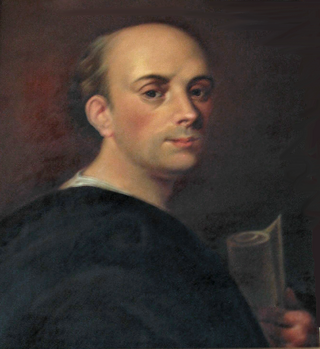
Scipione Piattoli was an Italian Catholic priest—a Piarist—an educator, writer, and political activist, and a major figure of the Enlightenment in Poland. After ten years as a professor at the University of Modena in Italy, he emigrated to the Polish–Lithuanian Commonwealth, where he became associated with several magnate families—the Potockis, Lubomirskis, and Czartoryskis. He was a member of Duchess Dorothea von Medem's court in Courland (Lithuania) and of King Stanisław August Poniatowski's court.

The Patriotic Party, also known as the Patriot Party or, in English, as the Reform Party, was a political movement in the Polish–Lithuanian Commonwealth in the period of the Four-Year Sejm of 1788–1792, whose chief achievement was the Constitution of 3 May 1791. The reformers aimed to strengthen the ailing political machinery of the Commonwealth, to bolster its military, and to reduce foreign political influence, particularly that of the Russian Empire. It has been called the first Polish political party, though it had no formal organizational structure. The Party was inspired by the ideals of the French Revolution, and its name, proudly used by themselves, was a tribute to the Dutch Patriots.

Count Stanisław Szczęsny Feliks Potocki, of the Piława coat of arms, known as Szczęsny Potocki was a member of the Polish szlachta and a military commander of the forces of the Polish–Lithuanian Commonwealth and then Poland. Knight of the Order of the White Eagle, awarded in August 1775.
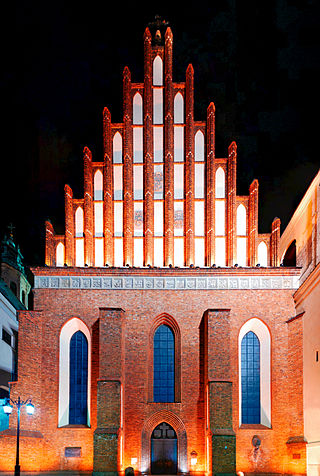
St John's Archcathedral is a Catholic church within the Old Town precinct in Warsaw, Poland. The Brick Gothic structure stands on Świętojańska Street, adjacent to the Jesuit Church. St John's is one of three major cathedrals in the city, but it is the only temple that also possesses the title of an archcathedral. It is the mother church of the Archdiocese of Warsaw and one of Poland's national pantheons. Along with the old city, the church has been listed by UNESCO as a World Heritage Site.
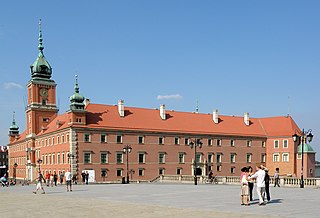
The Royal Castle in Warsaw was a seat of the Sejm and Senate of the first Rzeczpospolita and also an official residence of the monarchs in Warsaw. It contained the offices of a number of political institutions, arranged around a central courtyard.

Jan Dekert or Jan Dekiert was a Polish merchant of German descent and political activist. Starting in the 1760s, he rose to become one of the most prominent merchants in the Polish capital of Warsaw. He was an activist arguing for more rights for the burghers in the Polish–Lithuanian Commonwealth while opposing Jewish merchants. As the representative of Warsaw, he was elected a deputy to the Sejms of 1784 and 1786, as well as to the Great Sejm (1788–1792). He was the mayor of Warsaw (1789–1790), during which period he organized the Black Procession on 2 December 1789. This was a major step towards the passing of the Free Royal Cities Act enfranchising burghers, as one of the reforms of the Great Sejm and part of the Constitution of the 3rd May, 1791.

Black procession was a demonstration held by burghers of Polish royal cities in Polish–Lithuanian Commonwealth's capital of Warsaw on 2 December 1789, during the Great Sejm. It vastly contributed to the passage of a belated major urban reform.

Kazimierz Konopka was a Polish Jacobin, secretary of Hugo Kołłątaj, officer in the Polish Legions, aide-de-camp of Jan Henryk Dąbrowski. He gained notoriety for his involvements in the unrest and hangings in Warsaw during the Kościuszko Uprising.

Kołłątaj's Forge was a group of social and political activists, publicists and writers from the period of the Great Sejm in the Polish–Lithuanian Commonwealth.

The Friends of the Constitution was the first modern Polish political party, formed in May 1791, shortly after the adoption of the Constitution of 3 May 1791, by the efforts of the Patriotic Party. The purpose of the Friends of the Constitution was to defend the reformed political system and to introduce further reforms.



















